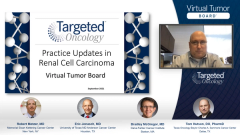
Case 1: CLEAR Trial in mRCC
Tom Hutson, DO, PharmD, reviews data from phase 3 CLEAR trial that evaluates efficacy and safety of frontline lenvatinib and pembrolizumab or everolimus or sunitinib.
Episodes in this series

Tom Hutson, DO, PharmD: To go into a little more detail, the phase 3 CLEAR study schema is shown here. This is the frontline lenvatinib-pembrolizumab or everolimus vs sunitinib. We’re concerned about the lenvatinib-pembrolizumab and sunitinib arms. To go on to this trial, patients needed to be treatment naïve and have advanced clear cell. It was a global trial, and as I mentioned, it was across all MSKCC [Memorial Sloan Kettering Cancer Center] or IMDC [International Metastatic Renal Cell Carcinoma Database Consortium] risk groups. The primary end point was PFS [progression-free survival] by independent review. The secondary end points were survival, response rate, safety, and health-related quality of life, and then exploratory was looking at duration of response and biomarkers. Of note, sunitinib was given at the traditional 4-weeks-on, 2-weeks-off dosing.
This is the Kaplan-Meier curve, and what 1 sees is a profound difference, a clear separation of the curves when 1 looks at lenvatinib-pembrolizumab compared with sunitinib. That separation is happening pretty early, roughly around 2 months, and we have a median progression-free survival for lenvatinib-pembrolizumab of 23.9 months, and sunitinib of 9.2 months. That’s a change of 14.7 months over sunitinib, which had been the gold standard in that setting. The hazard ratio is attractive at 0.39, representing a 61% relative-risk reduction and a highly statistically significant P value.
When we look at overall survival, we don’t have maturity, so it hasn’t been reached. But we do have the ability to look at a hazard ratio, and the hazard ratio for overall survival is attractive at 0.66 in favor of lenvatinib-pembrolizumab. When we get closer to the right-hand side, when we have smaller number of events to go to, we see some changes there that have brought a little concern, but it’s easily explained with the availability on progression of other agents that affect survival as well as the statistical issues of a small number of events. The long-term follow-up is going to be needed to make sure these curves stay separated. Also of note, the hazard ratio of 0.66 is very similar to the ipilimumab-nivolumab hazard ratio, which has brought some people to wonder: although the PFS and response rates may be higher with the I/O [immuno-oncology]–TKI [tyrosine kinase inhibitor], at the end of the day, what’s the survival going to look like between the 2.
Median duration of therapy was much greater with the lenvatinib-pembrolizumab as expected, despite being on therapy longer than that. We see a very attractive discontinuation rate of 9.7%, and that lets me know that although there are adverse effects with the combination, in clinical management only 10% of patients actually require discontinuing therapy because of 1 of these adverse effects. The lenvatinib-containing regimens do have a little more toxicity than what we’ve seen with sunitinib, and we’ve known that from earlier studies.
Robert Motzer, MD: Thanks very much for that overview. That’s a great high-level overview of the trials and a focus on the more recent reporting of the lenvatinib-pembrolizumab and lenvatinib-everolimus trial. Bradley, your center was 1 of the pivotal centers in terms of this clinical trial, the CLEAR trial, a major participant. What was your reaction to this CLEAR data?
Bradley McGregor, MD: We had the opportunity, and I personally had the opportunity, to put several patients on this trial. A lot of what I saw is that lenvatinib plus pembrolizumab certainly is a very active regimen across this group. The PFS in particular, as Tom pointed out, is impressive. A hazard ratio of less than 0.4 is an amazing response rate; it’s close to 70%, with impressive CR rates. They’re very encouraging data, and they do offer us another combination to be utilized in the clinic. That’s balanced by some of the safety concerns. I agree with Tom: only 10% had to discontinue both, but 25% discontinued pembrolizumab alone, a decent amount discontinued lenvatinib, and there were dose reductions. Thus, this regimen requires close follow-up and engagement with the patient, to monitor the patient, to be ready to do the dose reduction of lenvatinib and not be worried about pursuing those dose reductions. That was built into the trial, and the majority of patients did have to dose reduce. But certainly, it’s a great regimen, particularly if you need a response that for progressive disease a response of less than 6% is remarkable. Then you can feel comfortable that if you start this regimen, you’re likely going to get some clinical benefit and get that patient feeling better in the short term.
Robert Motzer, MD: That’s great advice. In terms of counseling the patient regarding efficacy and safety, what’s your approach, Eric, to the lenvatinib-pembrolizumab program and discussing the pros and cons with the patient?
Eric Jonasch, MD: I’ll echo what Brad said. This is a regimen that clearly has outstanding efficacy numbers but potentially will have some challenges from a toxicity perspective. What we’ve learned with TKIs over the decades is that it’s OK to take a break, to dose reduce. That does not seem to reduce the efficacy. In some ways, it may enhance it because patients’ bodies will basically let them know whether the dose is right. You adjust it to tolerability, and that seems to maintain efficacy. My advice to my patients is if you feel as if you need to take a break on Saturday morning, do it. Tell us about it on Monday. This isn’t a problem. The patient gets to drive the bus with regard to treatment decisions. We need to proactively help them and then dose reduce and adjust. If you do that, and as Brad pointed out, you get that efficacy. This is what happened in the majority of patients in this trial.
Transcript edited for clarity.








































